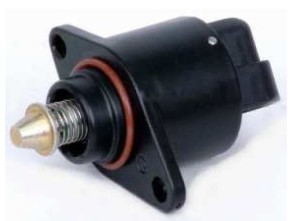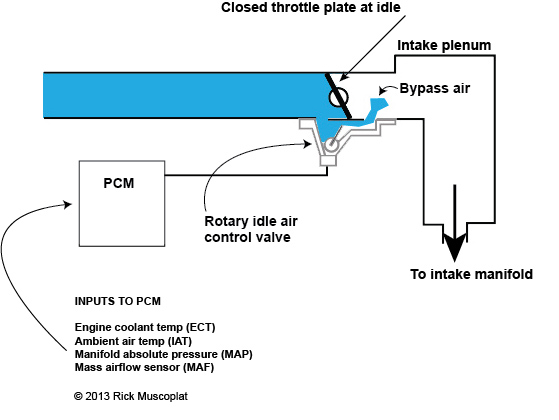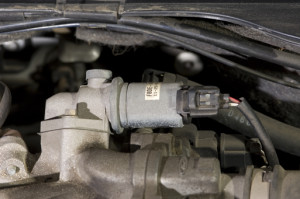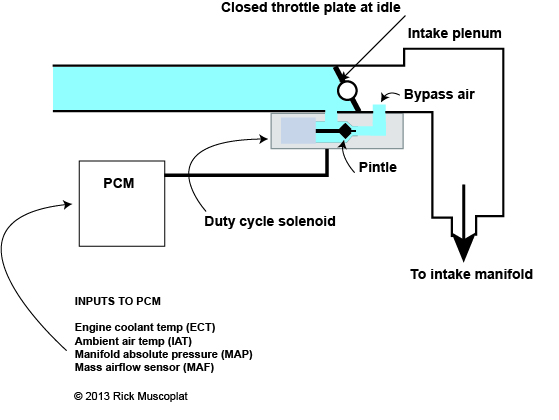How does an idle air control valve work
What is an idle air control valve
Many people are confused about how idle air control valves work. An idle air control valve literally bypasses air around a closed throttle plate so the engine can get air at idle. Because it bypasses air, it’s also called an air bypass valve.
Back in the days of carburetors, idle speed was adjusted by way of an idle speed screw. In fact, on many carburetors there were two idle speed adjustment screws; one for hot idle and another for cold. Turning the screw inwards prevented the throttle plate from closing all the way and the amount the throttle plate remained opened determined how much air could flow into the engine. Keep in mind that in order for a carburetor to work, air had to flow past the throttle plate and into a venturi in order to create vacuum to suck gas out of the carburetor bowl.
When the engine was cold, you’d depress the pedal part way and the choke would move the cam to the “cold” position and the cold idle screw would keep the throttle plate open much more than it would at hot idle. That allowed more air to pass, create more suction, and move more gas into the cold engine. On hot restart, the choke wouldn’t activate the cold idle cam and the throttle plate would only open enough to allow a small amount of air to enter. So you’d get just enough gas to keep the engine running when warm.
Fuel injected vehicles don’t work that way. First off, the throttle body doesn’t have a venturi. Its job is simply to regulated how much air comes into the engine—period. On start-up, the engine control module (ECM) or powertrain control module (PCM) checks engine coolant temperature, ambient air temperature, barometric pressure (on some engines) and then determines how much air and gas is required to start the engine. Car makers tell you to start a fuel injected engine WITHOUT depressing the pedal. That means the throttle plate is completely closed. How does the engine get air? From the idle air valve. The correct term for this part is the idle air bypass valve because its job is to BYPASS air around the throttle plate to provide combustion air at idle.
Car makers use five different styles of idle air bypass valves
Stepper-motor—In this system a stepper motor adjusts idle air bypass by opening and  closing a valve based on digital commands from the EDM/PCM. These valves generally have a tapered “pintle” that seats into a corresponding tapered seat. The stepper motor can position the pintle valve into one of 125 different possible “steps.” The higher the number of steps, the larger the airflow opening. If the stepper motor fails, it will default to its last commanded step position. Since all idle control valves are prone to carbon buildup, the ECM/PCM may perform an idle air control calibration sequence where it commands a full close and full open position while the engine is running. If the PCM detects more air passage at full closed that it expects, it can set a check engine light. That would indicate the need for cleaning or valve replacement.
closing a valve based on digital commands from the EDM/PCM. These valves generally have a tapered “pintle” that seats into a corresponding tapered seat. The stepper motor can position the pintle valve into one of 125 different possible “steps.” The higher the number of steps, the larger the airflow opening. If the stepper motor fails, it will default to its last commanded step position. Since all idle control valves are prone to carbon buildup, the ECM/PCM may perform an idle air control calibration sequence where it commands a full close and full open position while the engine is running. If the PCM detects more air passage at full closed that it expects, it can set a check engine light. That would indicate the need for cleaning or valve replacement.
Duty-control rotary solenoid. A rotary valve, as the name implies uses a movable rotary valve which blocks or exposes a bypass port based on command signals from the PCM. However, rather than operating in “steps” the valve has a default spring loaded closed position. Battery powered is run to the valve and the PCM pulses the ground on and off in rapid pulses to complete power to the solenoid. This method of pulsing a solenoid is referred to as duty cycle and is usually calibrated in 1/10’s of a second. If ground path is completed for 5/10’s of a second, it’s referred to as a 50% duty cycle.

Incoming air is stopped at the throttle plate. The rotary idle air control valve allows air to bypass around the throttle plate based on commands from the PCM
Duty-control air control valve (ACV) This is the style used in many Ford vehicles.  The valve has an internal tapered pintle and solenoid. It uses the same duty cycle circuitry as the duty cycle rotary valve described above.
The valve has an internal tapered pintle and solenoid. It uses the same duty cycle circuitry as the duty cycle rotary valve described above.

The PCM pulses ground to the solenoid making the pintle retract from its seat. That allows incoming air to bypass around the closed throttle plate.
On/off vacuum switching valve (VSV) In this style valve, a solenoid operated valve is switched open or closed by the PCM.
A thermostatically controlled valve is used in some applications. In this valve, a is pellet thermostat is located in contact with engine coolant. On a cold start, the thermostat doesn’t obstruct the air bypass port. However, as the engine coolant warms and the wax begins to melt, the wax expansion pushes a pintle to gradually reduce the amount of bypass airflow.
As mentioned earlier, idle air control valves can accumulate carbon buildup that can interfere with their operation. The symptoms may include hard cold starting, high idle speed, rough idle, or even a “hunting” or pulsing idle. Many DIYers immediately replace the idle air control valve. That’s understandable, but that usually doesn’t fix the problem. Instead, your first step should be to clean the tapered seat on the valve along with the idle air bypass passages. Spray them with throttle body spray cleaner. Then, check for vacuum leaks. A cracked vacuum hose can confuse the PCM, forcing it to issue conflicting commands to the Idle air control valve and cause a hunting idle.
MYTH BUSTING There’s a guy on Yahoo who insists that the idle air control valve is repsonsible for most engine problems and catalytic converter failures. He offers no proof of this, just his self-proclaimed opinion. You won’t find any documentation to support his theory in any shop manual. Here’s the bottom line: The idle air control valve works at idle and during deceleration. In other words, any time you take your foot off the pedal. During deceleration, the computers on most fuel injected vehicles do a “fuel cut” procedure where they stop operating the fuel injectors to force the engine to lose RPMs. However, since the pistons are still moving up and down, the engine still needs an air supply. The idle air control valve opens during deceleration to provide that air. Some people think that the idle air control valve fine tunes air/fuel mixture as you’re driving. It doesn’t. In fact, if you view a scan tool while driving, you’ll see that the PCM isn’t giving ANY commands to the idle air control valve. Take your foot off the pedal and you’ll see commands start up again during deceleration and fuel cut mode. The PCM fine tunes air/fuel mixture during driving by adjusting fuel injector operation, NOT by using the idle air control valve.
And, if your vehicle has an electronically controlled throttle body, chances are it doesn’t even have an idle air control valve. These electronically controlled “drive by wire” systems use a motor driven throttle plate–not a cable. So the throttle motor cracks the throttle plate open during deceleration and idle==not an idle air control.
If your vehicle has a high idle or hunting idle, click here to see how to fix it
To see a animation of an idle air bypass valve, click here.
© 2012 Rick Muscoplat
Posted on by Rick Muscoplat